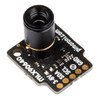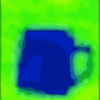

A sophisticated, hackable, 32x24 pixel thermal camera breakout! Use it to monitor the temperature of your CPU or coffee pot, or to build your own heat-seeking night vision camera. Works with Raspberry Pi or Arduino.
It's perfect for building into projects - industrial, scientific, or just fun - and much more affordable than most thermal cameras. Our breakout makes it easy to use the camera with your Raspberry Pi or Arduino, using I2C and 3-6V supply. This is the 55° (standard) version.
The MLX90640 far-infrared camera is an array of 768 (32x24) thermal sensors that can detect temperatures from -40 to 300°C with approximately 1°C accuracy and up to 64FPS! The applications of this camera are manifold: measure the heat or heat dissipation of devices like CPUs, circuit boards, or electrical appliances; use it to identify thermal inefficiencies in your home; or use it for presence detection to identify bodies in complete darkness.
Features
- Melexis MLX90640 far-infrared sensor array (datasheet)
- 32x24 pixels
- Field of view: 55°x35°
- Up to 64FPS
- -40 to 300°C detection with approximately 1°C accuracy
- I2C interface (address 0x33)
- 3.3V or 5V compatible
- Reverse polarity protection
- Compatible with all models of Raspberry Pi, and with certain Arduino models
- Mechanical Drawing
Includes
- MLX90640 breakout
- 1x5 male header
- 1x5 female right-angle header
This breakout board is designed so that you can solder on the piece of right-angle female header and pop it straight onto the bottom left 5 pins on your Raspberry Pi's GPIO header (pins 1, 3, 5, 7, 9).
Software
Note that the Breakout Garden installer will not automatically detect and install the thermal camera software, you'll have to install it manually. Full instructions can be found here.
Pimoroni has written software in C that you can use to generate images and video from the MLX90640 cameras.
SparkFun also provide an example Arduino/Processing sketch for the MLX90640.
Notes
- Dimensions: 19x19x2.75mm (LxWxH).
- Melexis state that up to 4 of the 768 IR sensor pixels in each array can be dead, with the unit still remaining in spec. The software will automatically detect and correct for dead pixels by interpolating readings from adjacent sensors - if you are using alternative software we recommend that you configure it to take a similar approach.




